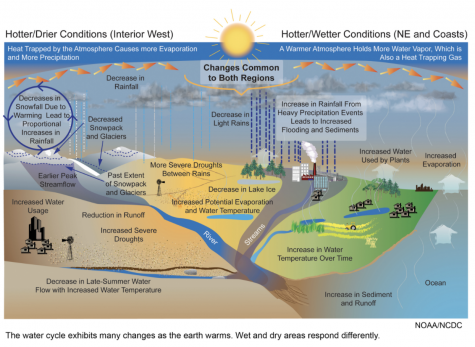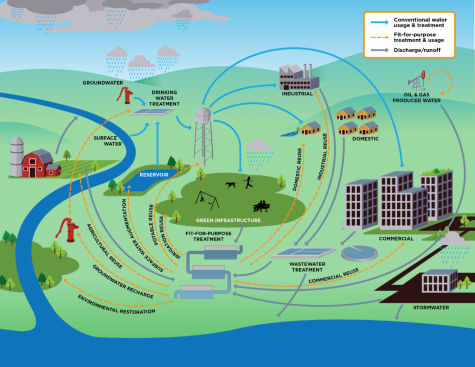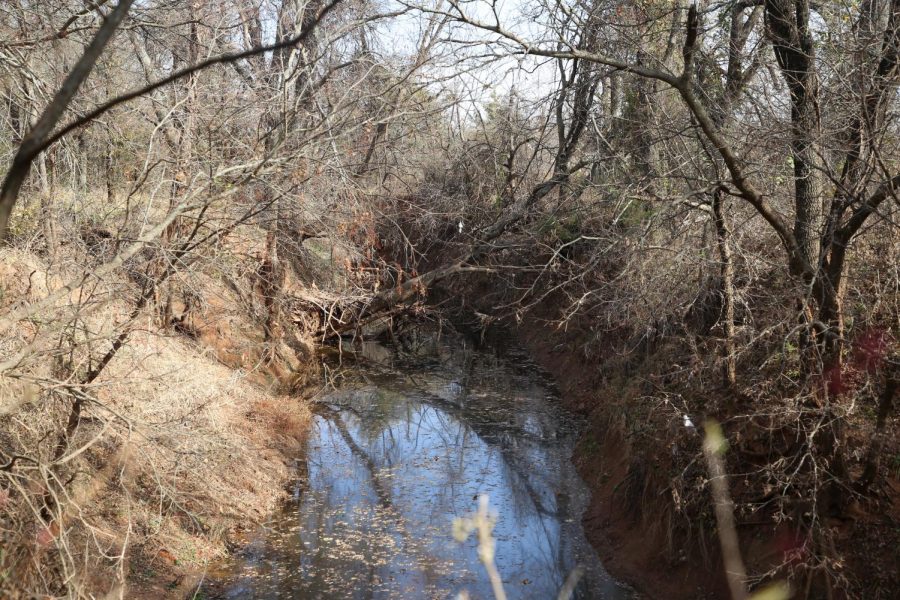We are alarmingly running out of water
A shallow creek located near S Mustang Rd is at risk of possibly drying out in the future.
Despite the obvious changes in weather and urgency among activists, if people still refuse to believe that the events of severe climate change aren’t of human cause, we won’t be able to fix the issues we currently face. The truth is we are losing water and consequences may arise as soon as 2025, according to the World Wildlife Fund, but with proper education on the culprits of water scarcity and how to prevent a devastating future, we can overcome these adversities and continue using water freely.
“Over the 21st century, the total land area subject to drought will increase and droughts will become more frequent and severe,” according to a 2021 assessment report by the Intergovernmental Panel on Climate Change.
Since only 3% of Earth’s water is suitable for human use we have to use it efficiently. Though, agriculture in multiple countries takes up a concerning amount of water to grow various crops to feed and clothe our growing population. Many thirsty crops are grown inefficiently in unsuitable environments leading farmers to water their crops more intensively. On top of using gallons of water on crops, tons of pollutants like insecticides and pesticides are sprayed on which contaminate our groundwater. Irresponsibly discarded waste from the general public and industries also negatively impacts our groundwater.
“In other instances—such as toxic substances from industrial processes—it may take years to build up in the environment and food chain before their effects are fully recognized,” according to the WWF.
The rapid increase in the human population will also strain our water supply and the environment overall. Demand for food will rise which will cause farms to use more water and cultivate more land. Households will be using more water for general purposes while also bringing up the potential of overloading sewage systems and water treatment plants. Economically, the heightened need for food and water will cause store prices to increase. These unprecedented demands also contribute to social and political unrest.
“Water shortages in Madhya Pradesh, India intensify during a heatwave, leading to numerous violent conflicts among Indian civilians. In one instance in Khajrana a water truck driver is beaten. In another instance in Panna, eight people are injured during a fight. The local government responds to the violence by ordering police to escort water trucks,” according to Worldwater.org.
On top of this, an increase in automobiles will pollute our roads and exert carbon emissions at a higher rate, increasing the Earth’s temperature. The economy and industrial growth will continue to follow current harmful practices, if changes don’t happen soon, and will continue to pollute and capitalize off of nature, damaging our ecosystems for money while acknowledging the consequences of doing so, such as Amazon that encourages consumerism and promises faster shipping which increases the number of vehicles on roads and planes in the sky. Also, during April this year, California Water Boards authorized Nestle, which is notoriously known for leaving a devastating water footprint, to stop their unlawful actions of stealing water from San Bernardino National Forest after receiving multiple complaints from people.
“However, in the candid words of Robert May (Climate Change Commission), we need to lose our obsession with free-market economics. Nature is valued in a myriad of ways by society and realizing these values, from market to spiritual and future use-values, is an important challenge,” Alison R. Holt and Caroline Hattam from the National Center for Biotechnology Information said.

(Noaa.gov)
We have to start being more aware of the water we use in order to protect it. So here are some things that you are able to do to minimize water stress. It may seem impossible to have any impact as an individual but as more people adopt these conservation habits the population as a whole will leave an extreme impact on the issue.
Minimizing your shower time to just four minutes can save a lot of water. The type of shower head you have also affects how much water you use. Most old showerheads use up to two gallons of water a minute, that’s enough to keep someone hydrated for seven days, compared to modern versions that only use around 1 gallon of water per minute. Check your showerhead and consider investing in a newer one if it’s old. Not only will you be doing the Earth a favor but a lot of new models come with unique spray features, height adjustment and a more compact spray while also saving you money in water bills.
“To save water in the shower, aim to get your shower time down to 4 minutes or less. Use a shower timer or your favorite 4-minute song to time your showers,” as mentioned by the Water Corporation of Australia.
Making the switch to refillable water bottles and filtered tap water, opposed to plastic water bottles, can also reduce the amount of plastic pollution within our waters, save you a lot of money and even decrease the gallons of water bottled and exported. Soda enjoyers could make the switch from buying packs of cans, which also includes a plastic lining inside, to Sodastreams, a personal fountain that carbonates water and comes with popular name brand syrups to be mixed along with it. If you continue to choose plastic bottles and canned sodas, then recycling should be considered. Contrary to belief, most communities have drop-off recycling centers and some areas even have dumpsters exclusively for recycling, though the former option is much more impactful as sometimes recyclable items don’t even get recycled.
“Other materials can’t be processed in certain facilities,” said Renee Cho from Columbia Climate School. “Moreover, many items that are collected, such as plastic straws and bags, eating utensils, yogurt and takeout containers often cannot be recycled. They usually end up being incinerated, deposited in landfills or washed into the ocean. While incineration is sometimes used to produce energy, waste-to-energy plants have been associated with toxic emissions in the past.”
You can also recycle water itself. Whenever you’re washing fruits or vegetables, fill up a bucket or large bowl with water and wash them in there. If your shower takes a while to warm up you can also place a bucket under the showerhead to capture the cold water. After you are done using the bucket and it’s filled with the cold or “dirty” water, go ahead and reuse that to water any plants you have or even clean with that water.

Utilize your washer and dishwashers wisely by filling them up to their maximum capacity and look out for energy-efficient appliances. When rinsing off dishes make sure no oils, grease or chemicals are drained because they can harm your pipes and contaminate groundwater. Instead, pour the prohibited substances into an empty container such as a coffee tub or empty can and dispose of it in your trashcan. Properly dispose of chemicals by researching how to dispose of them or call your local sanitation department for more instruction on how to dispose of them.

Easier approaches to contributing to water conservation are turning the sink off when not in use, applying an energy-efficient, multiple function hose-head to minimize water waste, cleaning outdoor areas with a broom instead of a hose and practice water-efficient gardening such as using mulch to slow down evaporation and keep water compacted.
Finally, encourage social change. Inform neighbors, family, friends and anyone you know to practice water conservation. Support activists, become politically involved and advocate for climate change to local senators and demand industries and companies to become more environmentally friendly. Apple is already alternating to greener habits by adapting to more ethical manufacturing by lowering water use and utilizing recycled material.
“We’re taking several steps to reduce our water impact, starting with selecting the right sites and designing for water efficiency and reuse. We’re also expanding our use of alternative water sources like recycled water, rainwater, and condensate. Finally, we are engaging with external stakeholders in the places we operate to ensure that our water stewardship plans meet local shared water challenges,” according to Apple’s website.
The future may look scary but we’re able to fight these challenges if we’re all efficiently made aware of this problem. For more information on water scarcity and how it’s being fought visit the Solar Impulse Foundation website at solarimpulse.com.
“Education is critical to solve the water crisis. In fact, in order to cope with future water scarcity, it is necessary to radically reform all forms of consumption, from individual use to the supply chains of large companies,” said the SIF
This former student was a sophomore and first-year staff writer for The Insight newspaper. They previously resided in Taft, California and went to Taft...





